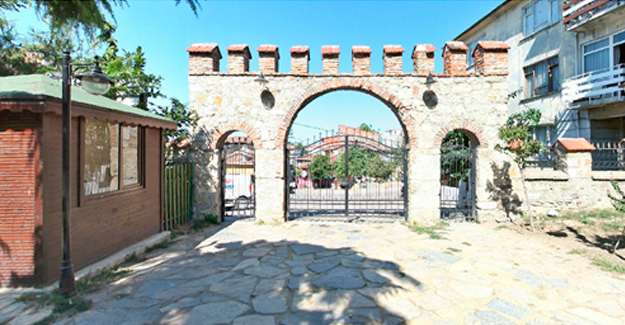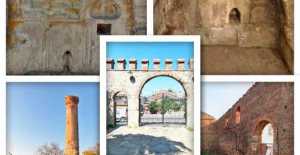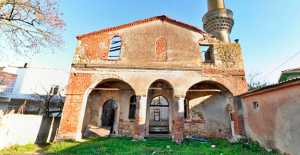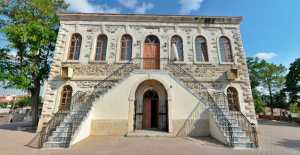Aradığını bulamadın mı? Buradan keşfet!
There is no official record of who built the famous walls of Silivri in Selymbria for the first time. However, it is thought that the city walls were built for protection during the establishment period of the city and were renewed and expanded in the following years.
Emperor Justinian, who repaired the wall of Anastasius, which was destroyed as a result of the earthquake in the 16th century, also had the Silivri Castle, which was damaged in the same period, repaired.
A few years later, between 741 and 775, Constantine V had the Silivri walls maintained. Silivri Castle was rebuilt for the last time as a result of the great damage it suffered after the earthquake of "Kiamet-i Suğra" (Little Doomsday). It was repaired by Bayezid between 1481 and 1512.
In the following periods, the walls lost their importance and were not renovated in any way. Silivri Castle was built in rectangular architecture. Since there are rocks descending from the southern part towards the sea, no walls were built in this part, and the remaining three facades were surrounded by walls.
The area covered by the castle is approximately 120 thousand square meters; The western side is 370 m long, the northern side is 350 m, and the eastern side is 310 m long.
The wall on the western front has not survived to the present day. In the southern part, it is thought that there is a gate created for the purpose of establishing a port connection. The main gates of the castle are located on the northern façade and are known to open to Via Egnatia, the inter-city road connecting Istanbul to the Adriatic Sea.
Fatih District, rising within the old castle walls; It is also known as Kale Mahallesi and Jewish Quarter. When the region fell into the hands of the Turkish people, Turks were settled in the neighborhood.
Aradığını bulamadın mı? Buradan keşfet!


 Emlak Konut Kazançlı Yatırım Kampanyası Detayları Açıklandı
Emlak Konut Kazançlı Yatırım Kampanyası Detayları Açıklandı SON DAKİKA: Silivri Kaymakamlığı'ndan Yasaklama Kararı!
SON DAKİKA: Silivri Kaymakamlığı'ndan Yasaklama Kararı! Silivri'nin ekonomik kalkınmasında yeni bir dönem başlıyor!
Silivri'nin ekonomik kalkınmasında yeni bir dönem başlıyor! Silivri'de Yeni Yaşam Alanları TOKİ'den geliyor: İstanbul'a 48 Bin 416 Konut!
Silivri'de Yeni Yaşam Alanları TOKİ'den geliyor: İstanbul'a 48 Bin 416 Konut! 'Rüşvet' iddialarına İlçe Başkanlığından açıklama
'Rüşvet' iddialarına İlçe Başkanlığından açıklama AK PARTİ SİLİVRİ İLÇE BAŞKANI MUTLU BOZOĞLU'NUN BASIN AÇIKLAMASI...
AK PARTİ SİLİVRİ İLÇE BAŞKANI MUTLU BOZOĞLU'NUN BASIN AÇIKLAMASI... BÖLGEMİZ MİLLETVEKİLİ TÜLAY KAYNARCA'NIN BASIN AÇIKLAMASI...
BÖLGEMİZ MİLLETVEKİLİ TÜLAY KAYNARCA'NIN BASIN AÇIKLAMASI... ZAFER YALÇIN:" ATATÜRK'ÜN PARTİSİNİ NE HALE GETİRDİNİZ?"
ZAFER YALÇIN:" ATATÜRK'ÜN PARTİSİNİ NE HALE GETİRDİNİZ?" SİLİVRİSPOR BASIN AÇIKLAMASI...
SİLİVRİSPOR BASIN AÇIKLAMASI... SİLİVRİSPOR SAHAYA İNİYOR…
SİLİVRİSPOR SAHAYA İNİYOR… SİLİVRİSPOR KALDIĞI YERDEN SERİYE DEVAM EDİYOR…
SİLİVRİSPOR KALDIĞI YERDEN SERİYE DEVAM EDİYOR… DÖRT BERABERLİKTEN SONRA GALİBİYETLE TANIŞTI…
DÖRT BERABERLİKTEN SONRA GALİBİYETLE TANIŞTI… Mahmut Topal Vefat Etti
Mahmut Topal Vefat Etti SİLİVRİ ŞEKERSİZ KALDI…
SİLİVRİ ŞEKERSİZ KALDI… BİLGİÇ OPTİK YAS TUTUYOR…
BİLGİÇ OPTİK YAS TUTUYOR… YASİN KARACA’YI KAYBETTİK…
YASİN KARACA’YI KAYBETTİK… BAŞIMIZ SAĞ OLSUN!
BAŞIMIZ SAĞ OLSUN! Çocuklarını Soğuk Suyla Yıkayıp Hortumla Döven Baba Tutuklandı!
Çocuklarını Soğuk Suyla Yıkayıp Hortumla Döven Baba Tutuklandı! Silivri Belediyesi'ne İhaleye Fesat Suçlaması mı Geliyor?
Silivri Belediyesi'ne İhaleye Fesat Suçlaması mı Geliyor? Silivri için Yeni Kar Yağışı Uyarısı
Silivri için Yeni Kar Yağışı Uyarısı Silivri’de Film Gibi Olay: Çalıntı Araç ve Jandarma Aracıyla Kaçış!
Silivri’de Film Gibi Olay: Çalıntı Araç ve Jandarma Aracıyla Kaçış! VİDEO HABER...
VİDEO HABER... SİLİVRİ'DE ÇOCUKLARA BAYRAK DAĞITILDI... VİDEO HABER
SİLİVRİ'DE ÇOCUKLARA BAYRAK DAĞITILDI... VİDEO HABER ÇOCUKLARA KORONAVİRÜSÜ NASIL ANLATMALIYIZ? VİDEO HABER
ÇOCUKLARA KORONAVİRÜSÜ NASIL ANLATMALIYIZ? VİDEO HABER























 Silivri Köy Köy Mahalle Mahalle Milletvekilliği Seçim Sonuçları
Silivri Köy Köy Mahalle Mahalle Milletvekilliği Seçim Sonuçları
 Silivrispor 1 - Erzurumspor 0
Silivrispor 1 - Erzurumspor 0
 2019 DA BELEDİYE BURÇLARINA AK PARTİ BAYRAĞINI DİKECEĞİZ…
2019 DA BELEDİYE BURÇLARINA AK PARTİ BAYRAĞINI DİKECEĞİZ…
 AK Parti Silivri Gençlik Kollarına Bir Günde Kaç Kişi Katıldı?
AK Parti Silivri Gençlik Kollarına Bir Günde Kaç Kişi Katıldı?














